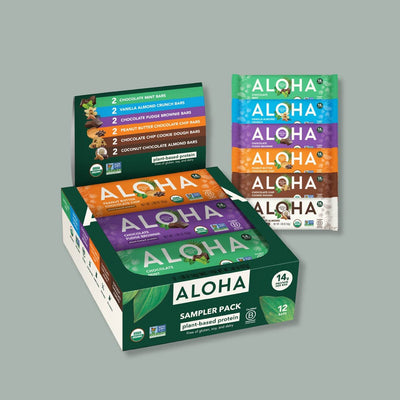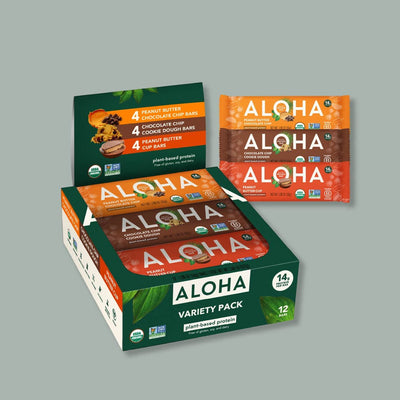Key Takeaways:
- Taro Has Deep Cultural Roots: Used for generations in traditional diets across the Pacific Islands, Asia, and Africa, taro is more than just a food—it’s part of a legacy of nourishing, real ingredients.
- Cooking Taro Properly Is Essential: Raw taro isn't safe to eat, but when peeled and fully cooked, it becomes a soft, flavorful ingredient that blends seamlessly into various plant-based recipes.
- ALOHA Offers a Convenient Way to Enjoy Taro: The ALOHA Taro Bar makes it easy to enjoy this nutrient-rich root on the go, with no prep required and a thoughtful ingredient list.
Why are more people turning to lesser-known root vegetables like taro to add variety to their plant-based diet? This starchy root, known for its creamy texture and subtle, nutty flavor, appears in everything from smoothie bowls to snack bars. As interest in whole, minimally processed foods continues to grow, taro has become part of the conversation—but there’s still a lot of curiosity around what it brings to the table.
At ALOHA, we’re passionate about honoring ingredients that have stood the test of time. Our commitment to creating organic, non-GMO, and plant-based snacks isn’t just about trends but also about trust, transparency, and taste. That’s why we highlight ingredients like taro, not just for their story but for their real food value.
In this piece, we’ll explore taro’s nutritional profile, highlight its benefits, and answer the question many health-conscious eaters ask: is taro healthy?
Nutritional Profile Of Taro
Taro is a complex carbohydrate that offers more than just energy. As a root vegetable, it contains naturally occurring starches along with a modest mix of vitamins and minerals. Its whole-food simplicity makes it appealing for plant-based eaters—no additives, no lab-made ingredients, just a nutrient-dense root with a long history of use in traditional diets.
In its cooked form, taro provides key nutrients like manganese, potassium, and vitamin E. It also contains some fiber, which supports a balanced approach to eating and can help make meals feel more satisfying. While it's not a high-protein food, taro’s value lies in its versatility and pairing with other whole, plant-based ingredients.
So, is taro healthy? If you focus on clean ingredients, balance, and variety in your diet, taro can earn a spot in your rotation.
Health Benefits Of Taro
Taro is more than just a starchy side—it’s a versatile root that brings natural value to a balanced, plant-based diet. Below are a few reasons why this traditional crop still holds up today:
A Source Of Natural Fiber
Taro contains fiber in its whole, cooked form, which helps add structure and fullness to meals. This makes it a smart addition to dishes where balance is key—especially for those building a diet centered on whole, plant-based ingredients. For many asking if taro is healthy, this fiber content is one of the first things that stands out.
Traditional Fuel For Daily Life
In many cultures, taro is more than food—it’s tradition. Used for generations in regions like Hawaii, Southeast Asia, and West Africa, it has long served as a foundational energy source in everyday meals. Its steady reputation as a household staple speaks to its reliability as part of a well-rounded, nourishing lifestyle.
Complements A Variety Of Dishes
One of the best things about taro is its easy use in cooking. It absorbs flavor well and has a creamy, starchy texture that suits both savory dishes—like soups and stews—and sweet treats such as puddings and baked goods. Whether roasting, boiling, or steaming it, taro offers flexibility without overcomplicating your meal prep.
Naturally Free From Common Allergens
In its whole form, Taro is free from several common allergens, including gluten, soy, and nuts. This simplicity makes it a go-to option for people with specific dietary preferences or sensitivities, especially when looking for minimally processed, single-ingredient foods. It’s another reason people exploring plant-based alternatives ask, "Is taro healthy compared to other starches?"
Rooted In Cultural And Culinary Tradition
Beyond its nutritional qualities, taro is tied to deep cultural roots. From Hawaiian poi to Filipino “ginataan,” it plays a key role in dishes that are meaningful, celebrated, and passed down through generations. Including taro in your meals is a way to connect with global food traditions in an authentic, respectful way.
Is Taro A Good Fit For Plant-Based Diets?
Whole-food ingredients are the foundation of everyday meals for those following a plant-based lifestyle. Taro fits naturally into this approach, offering a simple, earthy option that adds variety and texture without relying on overly processed alternatives. Here's why taro holds a solid place on the plant-based plate:
- A Whole-Food, Plant-Based Ingredient: Taro is a single-ingredient root that doesn’t require any fancy processing to be enjoyed. When cooked, it becomes soft and creamy, making it ideal for comforting meals and simple snacks. For those who prefer to eat closer to nature, taro checks the box for minimal interference between harvest and table.
- Naturally Vegan and Gluten-Free: Taro supports a wide range of dietary preferences without any animal products or gluten in its natural form. It can be used as a base in meals or snacks that are fully plant-powered and work well with other ingredients like coconut milk, spices, and legumes.
- A Great Way to Add Variety: Adding diversity to your plant-based meals can sometimes be challenging. Taro brings something new to the table—both in texture and flavor. It’s a subtle shift from everyday staples like potatoes or rice, offering a creamy mouthfeel and mild taste that adapts well to different cooking styles.
How To Eat Taro Safely
Taro is versatile and nutrient-dense, but like many root vegetables, it needs to be prepared properly before eating. Raw taro contains naturally occurring compounds that should be neutralized through cooking. If you’re new to this root, here’s what you need to know before adding it to your routine:
1. Always Cook Before Eating: Taro should never be eaten raw. Cooking removes naturally occurring compounds found in the root, making it safe and enjoyable to eat. Boiling, steaming, or baking are all common ways to prepare taro for sweet and savory dishes.
2. Peel It Thoroughly: Before cooking, the skin should be removed completely. It’s thick and rough, so a sharp knife works better than a traditional peeler. Wearing gloves while peeling can also help, as the raw skin may cause mild skin irritation for some people.
3. Use Simple Cooking Methods: Taro is best enjoyed when cooked simply. Boil chunks until tender, mash them like potatoes or cubes, and roast them until golden. For a more traditional experience, try it in soups and stews or blended with coconut milk for a creamy, comforting base.
How To Incorporate Taro Into Your Diet
Taro isn’t just a root—it’s a canvas. Its neutral flavor and creamy texture make it a versatile ingredient that works in a surprising range of recipes. Whether you're looking for something comforting or a fresh twist on your favorite dishes, taro offers plenty of possibilities without complicating your routine. Here's how you can start bringing it into your plant-based meals:
Add It To Savory Dishes
Cooked taro is hearty and comforting, making it a great addition to warming meals. It absorbs flavors well and pairs nicely with broths, herbs, and spices. You can dice it into soups and stews to replace other starches like potatoes or toss it into curries for a creamy bite that holds its shape.
For something simple, try steaming or boiling taro chunks and lightly seasoning them with salt and olive oil. You can also pan-fry slices for a golden, crispy edge or mash them as a satisfying side to roasted vegetables or sautéed greens.
Use It In Sweet Treats
Taro’s mild natural sweetness makes it just as welcome in desserts. In many Asian and Pacific Island cultures, it’s featured in puddings, ice cream, and pastries. You can make a taro coconut pudding by blending it with plant-based milk and a hint of maple syrup or cinnamon. It also works well in baked goods like muffins or mochi, adding a unique texture and subtle flavor that stands out in a good way.
If you're a fan of meal prepping, try cooking and chilling taro in advance—it blends beautifully into sweet recipes throughout the week.
Blend It Into Smoothies Or Bowls
Try adding pre-cooked taro to your smoothie or bowl for a new twist on your morning routine. It blends into a thick, creamy texture, giving your blends a rich, velvety consistency. It pairs especially well with tropical ingredients like banana, coconut, pineapple, and cacao. Ensure it's fully cooked and cooled before tossing it into the blender.
This is also a great way to use leftover taro in a way that feels fresh and energizing.
Explore Traditional Recipes
One of the most rewarding ways to use taro is by exploring its cultural roots. From Hawaiian poi to Filipino “ginataan” (a coconut milk-based stew) to Chinese taro cakes, there’s a world of tradition behind this one root vegetable. Not only do these dishes offer new flavors and textures, but they also invite you to connect with time-honored cooking methods from around the world.
Whether you follow a recipe to the letter or put your own spin on it, cooking taro in traditional styles is a thoughtful way to enjoy the ingredient in its full context.
Try It In A Convenient, On-The-Go Form
For an easy introduction to taro—without having to cook it yourself—you can find it in select ALOHA protein bars, including our special edition Taro Bar. It features the Lehua variety of taro from Hawaii’s Hanalei Valley, paired with ingredients like macadamia nuts. It’s a delicious way to experience taro as part of a clean, plant-based snack made with intention and care.
Final Thoughts
In a world where food choices are becoming more intentional, taro stands out for its versatility and alignment with a lifestyle rooted in simplicity, balance, and tradition. It’s not about chasing the next superfood—it’s about embracing ingredients that nourish in meaningful and practical ways. So, is taro healthy? When prepared properly and enjoyed as part of a whole-food, plant-based diet, taro is absolutely a healthy and worthwhile addition to your plate.
Read also:
- Does Protein Make You Feel Full? Benefits Explained
- How Does Fiber Help Your Body? Health Benefits Explained
- How To Get Protein Without Meat: Top Plant-Based Sources
Frequently Asked Questions About Taro
Is taro considered a superfood?
Taro isn’t officially labeled a superfood, but it does have qualities that make it appealing for balanced, whole-food diets. It’s versatile, easy to use in sweet and savory recipes, and a staple in many cultural traditions. While the term “superfood” is often marketing-driven, taro earns its spot through simple, natural value.
Is taro safe to eat during pregnancy?
When fully cooked, taro is generally safe to include in a well-rounded diet during pregnancy. Like any new food, it’s best introduced in moderation and prepared properly. Anyone with specific dietary concerns should consult a healthcare provider first.
Is taro good for kids?
Yes, taro can be a good food option for kids when cooked thoroughly and served in easy-to-eat forms like mashed or blended into dishes. Its naturally mild taste makes it kid-friendly. Just be sure it’s soft, fully cooked, and served in age-appropriate textures.
Is taro flour the same as taro root?
Taro flour is made by drying and grinding the root into a powder, a processed version of the whole vegetable. While they come from the same plant, the nutritional profile may differ slightly depending on how it’s prepared and used. Taro flour is typically used in baked goods or as a thickener.
Can you freeze cooked taro?
Yes, you can freeze cooked taro for later use. Make sure it’s cooled completely before storing it in an airtight container. The texture may soften further when reheated, making it best suited for mashed dishes, soups, or blended recipes.
What does taro taste like?
When cooked, taro has a slightly nutty, mildly sweet flavor with a creamy, starchy texture. It's often compared to a mix of potato and chestnut. The flavor is neutral enough to work in a wide range of dishes.
Is taro grown in the U.S.?
Yes, taro is grown in the United States—most notably in Hawaii, where it's cultivated in traditional lo‘i (wetland farms). The Lehua variety used in the ALOHA Taro Bar is sourced from Hanalei Valley on Kaua‘i, an area known for its rich volcanic soil and sustainable farming practices.
Can taro be eaten every day?
Taro can be eaten regularly when prepared properly and paired with other whole foods in a balanced diet. Like any starchy vegetable, variety is key to keeping your meals interesting and nourishing. Cooking taro in different ways helps avoid repetition and keeps it enjoyable.
What’s the difference between taro and ube?
Taro and ube are both purple root vegetables, but they come from different plants and have distinct flavors. Ube (purple yam) is typically sweeter and more vibrant in color, while taro is earthier and lighter in shade. They're often used in similar recipes, especially in desserts.
Are taro leaves edible?
Yes, taro leaves can be eaten, but must be cooked thoroughly to neutralize naturally occurring compounds. They're commonly used in stews and wrapped dishes in various cuisines. Like the root, the key is cooking the food fully before serving.
Sources:
1. Ferdaus, M. J., Chukwu-Munsen, E., Foguel, A., & da Silva, R. C. (2023). Taro Roots: An Underexploited Root Crop. Nutrients, 15(15), 3337. https://doi.org/10.3390/nu15153337
2. Himeda, M., Njintang, Y. N., Gaiani, C., Nguimbou, R. M., Scher, J., Facho, B., & Mbofung, C. M. F. (2012). Physicochemical and thermal properties of taro (Colocasia esculenta sp) powders as affected by state of maturity and drying method. Journal of Food Science and Technology, 51(9), 1857–1865. https://doi.org/10.1007/s13197-012-0697-9
3. Beato, Z., Gitonga, L. N., Amonsou, E. O., & Reddy, V. (2023). Nutritional evaluation of Colocasia esculenta (L.) Schott leaves and corms from KwaZulu-Natal, South Africa. Journal of Food Composition and Analysis, 126, 105831. https://doi.org/10.1016/j.jfca.2023.105831
ALOHA's products are not intended to treat, diagnose, mitigate, prevent, or cure disease. ALOHA's products should not replace prescribed medications or the variety of foods important to a healthful diet.
Do not self-diagnose any health condition. Work with your healthcare provider to determine how best to achieve optimal health.












